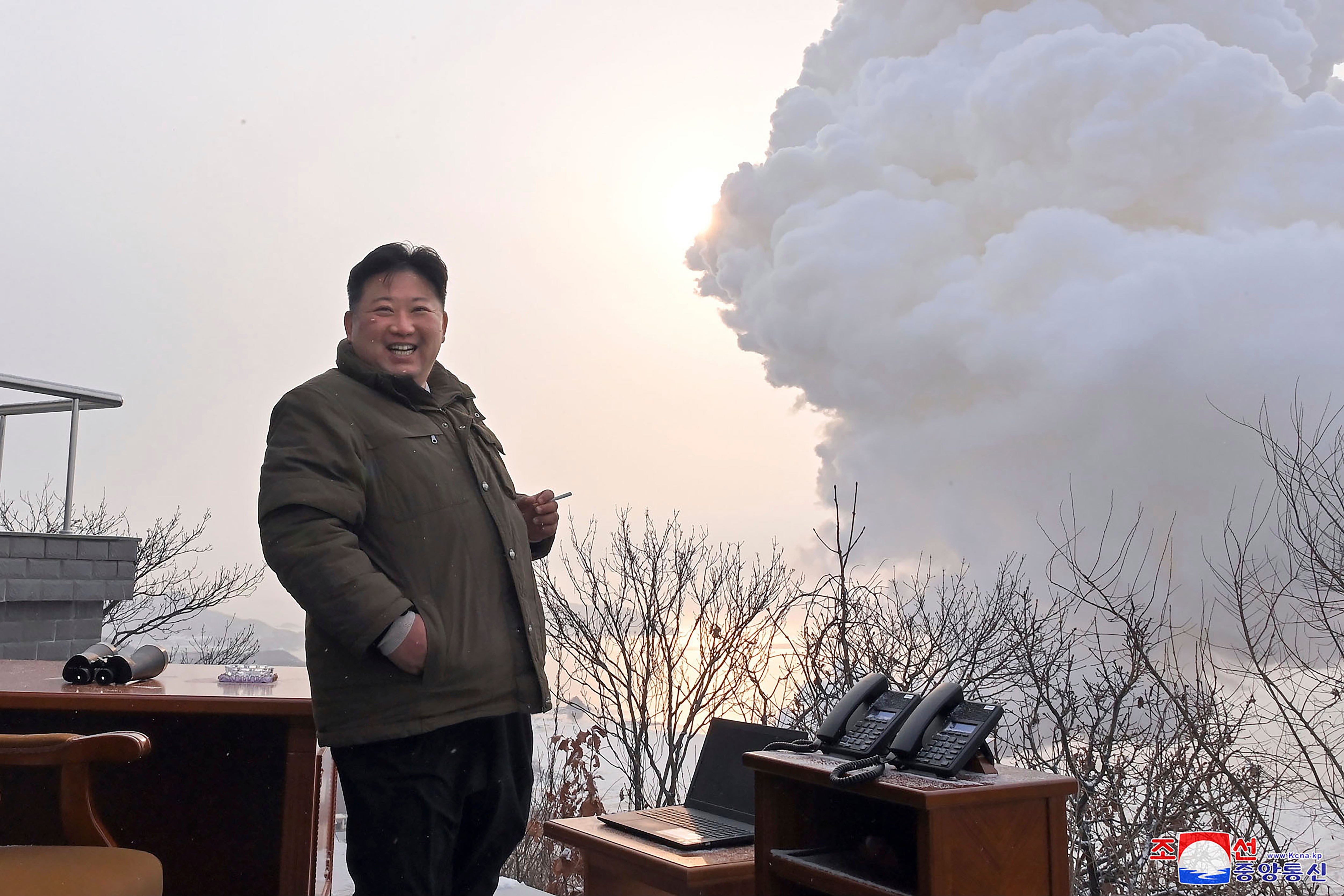Kim Jong-un oversees North Korea test of key component for more powerful ICBM
If successful, ‘high-thrust solid-fuel motor’ test a significant step for North Korea’s nuclear-capable missile development

A visibly cheerful Kim Jong-un was present at the test launch of a “high-thrust solid-fuel motor”, a key component for North Korea’s intercontinental ballistic missiles and a new strategic weapon in its military arsenal, reported state media on Friday.
The successful launch of “high-thrust solid-fuel motor” could arm North Korea to develop a more mobile, harder-to-detect arsenal of ICBMs missiles that pose a direct threat to the mainland US.
This was the first of its kind launch of “static firing test” of a missile engine carried out in the country’s northwest rocket launch facility, reported the official Korean Central News Agency.
Inside the weapon, the fuel in solid-propellant rockets is already fitted which helps shorten the launch preparation times.
As for the outsiders, the increased weapon’s mobility makes it difficult to detect what is happening before liftoff - giving the launchers an advantage of concealing the actual launch duration before the projectile hits the target.
Testing of the solid fuel provided the Kim Jong-un regime a “sure sci-tech guarantee for the development of another new-type strategic weapon system”, the KCNA said.
Photos of the launch showed the North Korean leader laughing and smoking a cigarette at the Sohae satellite launching ground on Thursday.
A powerful fire beam from the mouth of the motor is visible at the rocket launching platform in the north Pyongan province in the second photo shared by the Korean state media.
The prominent launching ground has been used by Mr Kim’s father in 2012 for a North Korean satellite. Fresh satellite images in 2019 showed a likely reconstruction of the critical launching station.
Mr Kim lauded the scientists and technicians involved in the test and said that he expected the new weapon to be built “in the shortest span of time”, the state media report added.
This is likely indicating North Korea’s plan to come up with a solid-fueled ICBM as promised by Mr Kim during a major ruling party’s conference last year, after which the hermit kingdom has massively expanded its military arsenal and carried out more than 80 missile launches.
The top leader has also promised to manufacture a multi-warhead missile, underwater-launched nuclear missiles and spy satellites.
Experts have said that if North Korea’s high-thrust solid-fuel motor ground test at Sohae is nearly as successful as they claim, it is a significant step for the country’s nuclear-capable missile development.
“Compared to liquid-propellant weapons, solid-fuel missiles are more mobile, quicker to launch, and easier to conceal and use during a conflict,” said Leif-Eric Easley, a professor at Ewha University in Seoul.
“Pyongyang’s claim of testing a solid-fuel motor for longer range ballistic missiles supports its more aggressive, recently declared doctrine of using nuclear weapons if the Kim leadership or strategic assets come under threat,” the professor told The Independent.
Once deployed by the Kim regime, the technology would make North Korea’s nuclear forces “more versatile, survivable, and dangerous”, he said.
Some experts have warned that using a built-up and expanded arsenal, North Korea can turn to its rival Washington to seek relief on sanctions and other concessions.
Ankit Panda, an expert with the Carnegie Endowment for International Peace, said that this kind of motor test was expected for a while among those monitoring North Korea.
“Large-diameter solid propellant rocket motors will enable North Korea to deploy larger submarine-launched missiles and, more importantly, more survivable and responsive intercontinental-range ballistic missiles,” he said.
But added that unlike liquid propellant missiles, “solid propellant missiles are fueled at the time of manufacture and can thus be released far more quickly in a war, all else being equal”.
“I wouldn’t be surprised if they’d look to do additional testing and development of these motors before moving to flight-testing,” Mr Panda said.
The KCNA said that the test from Thursday was to verify specific technical features of the high-thrust solid-fuel motor based on the thrust vector controlling technology. It claimed that the test results showed all the technical indices proved its reliability and stability.
Experts have said the veracity of North Korea’s claims is difficult to assess.
“What is potentially significant is the claimed ‘thrust vector controlling technology,’ with imagery suggesting gimbaled exhaust nozzle which can redirect the thrust to effectively steer the missile,” said Joseph Dempsey, research associate for defense and military analysis at the International Institute for Strategic Studies.
This is a far more advanced method of thrust vectoring than a previous method traditionally used on the North’s solid motor missiles.
“Testing a gimbaled nozzle could therefore represent an important technological waypoint toward North Korea’s stated goal of a solid motor ICBM,” Mr Dempsey said.
What remains unknown are the other technical challenges and how far away a flight test of such a system is.
Subscribe to Independent Premium to bookmark this article
Want to bookmark your favourite articles and stories to read or reference later? Start your Independent Premium subscription today.

Join our commenting forum
Join thought-provoking conversations, follow other Independent readers and see their replies